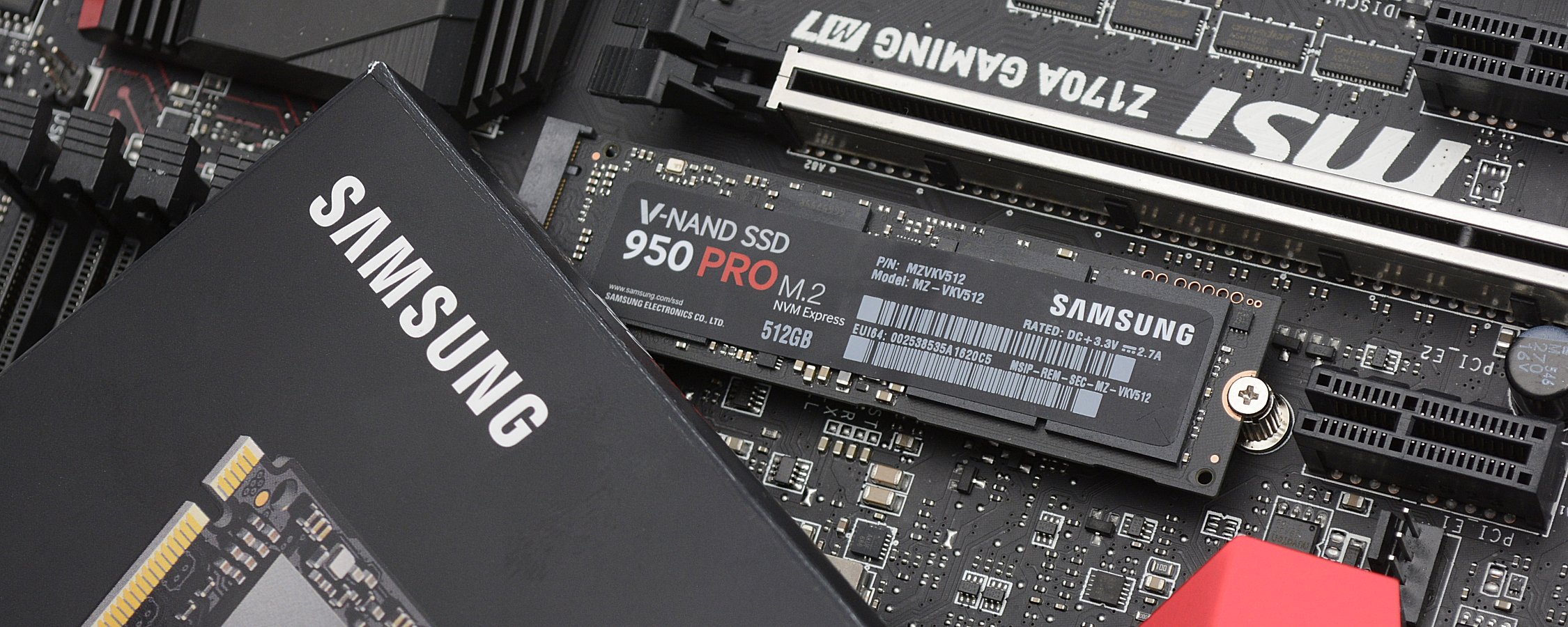It's been five years since Samsung stormed into the solid state scene with the SSD 470 Series. Call them early days of SSD adoption, the company successfully faced foes such as the Crucial RealSSD C300 and OCZ Vertex 2.
After this stellar first run, Samsung followed through with the SSD 830 Series, offering great value at $1.50 per gigabyte versus $2.22 per gig for an Intel SSD 510 of the same capacity. A year later the SSD 840 Pro brought fame and fortune to the lineup along a larger 512GB drive ($1.17 per GB). Then last year saw the arrival of 1TB SSD 850 Pro drives, and you can now buy a 2TB version for $0.50 per gig.
We've finally reached the point where you can buy high capacity SSDs, although they are largely bound by the bandwidth limitation imposed by the SATA 6Gb/s interface, with top performing Samsung's SSD 850 Pro offering sequential read and write speeds of 550 to 520MB/s.
A solution to this problem was revealed midway through 2014 with Intel's Haswell refresh. The Z97 chipset packed support for the M.2 and SATA Express interfaces, both of which were designed to take mainstream SSD performance to the next level.
So far SATA Express has been a complete bust while M.2's uptake has been slow, but things are in full swing now. Samsung was the first manufacturer to show what M.2 was capable of with its OEM XP941 PCIe SSD. Using four PCI Express lanes the XP941 was good for read and write speeds of 1,170 to 950MB/s.
Earlier this year the XP941 was replaced with an even faster Samsung M.2 SSD, the SM951 which boasted read and write speeds of 2,150 to 1,500MB/s and was later upgraded to support the new NVMe command set, offering even greater performance.
Since the arrival of the these initial M.2 SSD products, we've been waiting for a more affordable mainstream release, and that's exactly what the SSD 950 Pro delivers. Made exclusively in the M.2 2280 form factor, the SSD 950 Pro comes in 256GB or 512GB capacities.
The 512GB model boasts a sequential read speed of 2.5GB/s and a write speed of 1.5GB/s making the 950 Pro reads superior than the SM951 NVMe. It's also more affordable at $350 for the 512GB model, which is widely available to the public unlike previous OEM-only drives.
Samsung 950 Pro 512GB
The Samsung 950 Pro is available in just two capacities, with no affordable 128GB option in sight. The 512GB model costs $350 which is a relatively high $0.68 per gigabyte, while the 256GB model costs $190 for an even more costly $0.74 per gigabyte.
Featuring the same UBX 3-core controller found in the SM951, the 950 Pro receives native PCIe and NVMe support. For those of you wondering, the 850 Pro series used the MEX controller, a native SATA 6Gb/s controller.
Surprisingly, the SM951-NVMe was paired with Samsung's 16nm 64Gbit MLC NAND flash where as the mainstream 850 Pro series received the more advanced Samsung 3D V-NAND (32-layer 86Gbit MLC) flash. This is where the 950 Pro has been upgraded, as the UBX controller has been paired with Samsung's 3D V-NAND (32-layer 128Gbit MLC).
Therefore technically there is nothing "new" about the 950 Pro series, it just combines all the best bits that Samsung has brought to market so far.
For those of you not up to speed with V-NAND technology here is a quick explanation. Samsung's V-NAND overcomes density limitations, performance and endurance of planar NAND by stacking the layers vertically, rather than decreasing the dimensions of the cells to try to fit them on a fixed horizontal space. The result is higher density, better endurance and superb performance in a smaller footprint than conventional planar NAND architecture
The claimed sequential performance is staggering as the 512GB model boasts a read throughput of 2.5GB/s and a write speed of 1.5GB/s. The 256GB model is quite a bit slower but still blistering fast compared to any SATA SSD with a read speed of 2.2GB/s and a write speed of 900MB/s.
To achieve this kind of performance the 950 Pro series uses the PCIe 3.0 x4 interface which provides 32 Gbit/s or 3.93GB/s of bandwidth. The XP941 for example used the PCIe 2.0 x4 interface which limited it to a maximum throughput of 20Gbit/s (2GB/s) and this simply won't be enough for the 950 Pro.
This is interesting as the Z97 chipset, which first introduced the M.2 slot on the desktop, only supports up to eight PCIe 2.0 lanes with the rest of the PCIe lanes being hogged by graphics cards. All this changed with Skylake as the Z170 can support twenty PCIe 3.0 lanes through the chipset, so putting aside four of those lanes for an M.2 slot to power the 950 Pro isn't an issue.
The 950 Pro series is backed by a five-year limited warranty, the warranty is limited by how much data can be written. The 256GB version is capped at 200 terabytes written (TBW) while the larger 512GB model doubles that to 400 TBW. This means both models see an increase in the TBW limit over the 850 Pro by 50 TBW (256GB comparison) and 100 TBW (512GB comparison).
To ensure overheating does not become an issue like it did with the XP941, Samsung has equipped the 950 Pro series with Dynamic Thermal Throttling Protection technology, which monitors and maintains the drive's optimal operating temperature. The throttle feature automatically drops the temperature of the SSD when it reaches a certain threshold, protecting the data and drive while ensuring continual responsiveness.
As an added safeguard, the 950 Pro includes the Self-Monitoring, Analysis and Reporting Technology (S.M.A.R.T.) feature. This valuable feature tracks the health status of the SSD, monitoring it to detect and report on a variety of reliability indicators. S.M.A.R.T. is designed to anticipate failures and warn users of impending ones, enabling users to proactively replace an ailing drive, preventing data loss and unexpected outages.




